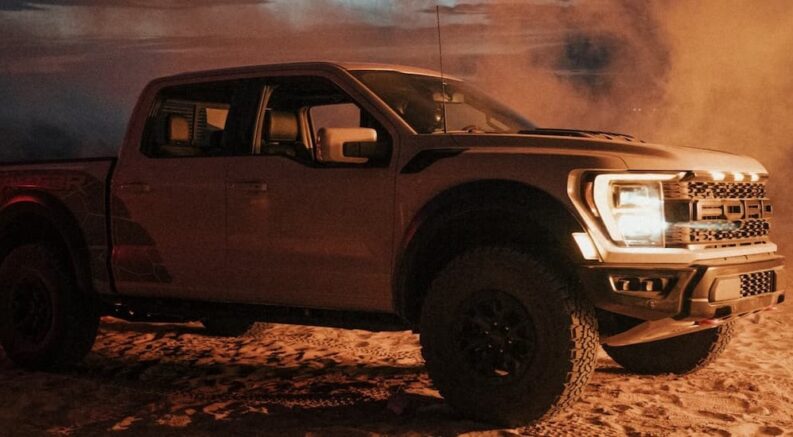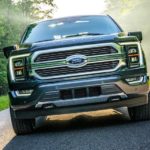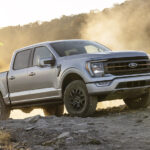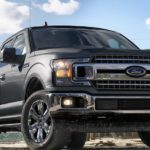When you’re shopping for a Ford F-150 these days, you have seemingly countless options available. From high-value options like the XL, STX, and XLT to premium trims like the Lariat, King Ranch, and Platinum to off-road models like the Tremor, Raptor, and Raptor R, there is an F-150 model for everyone. But it wasn’t always this way. If you’re looking for an older used Ford F-150 for sale, you’ll realize that several of these trims are rather new, and the further back you go, the more alien the F-150 trim lineup becomes. In fact, for the first few years of its existence, the F-150 Ranger was the trim to get, even though that name is now used for an entirely different truck. So, how did we get where we are today, and when did the most popular F-150 options hit the scene?
The F-150 Ranger Appears
The history of the F-Series trucks goes all the way back to shortly after the end of World War II, but the F-150 didn’t arrive until 1975 when Ford decided to split the difference between the F-100 and the F-250 to avoid new emissions regulations. The original F-150 was offered in just three trims, none of which still exist today: the Custom, the Ranger, and the Ranger XLT. The Ranger name had first appeared for the 1965 F-Series, adding previously unheard-of luxuries like bucket seats and a cover for the in-cab fuel tank.
For the 1975 F-150 Ranger, things had been dialed back slightly, with the trim offering a “Super-soft” vinyl bench seat, wall-to-wall nylon carpeting, a cigarette lighter, and simulated woodgrain trim on the steering wheel. If you opted for the top-level Ranger XLT, then you were upgraded to cloth and vinyl seats, cut-pile carpeting, a glove box, and an ashtray to go with the cigarette lighter. The truck world was a very different place 50 years ago.
Here Comes the Lariat
The 1978 model year saw the introduction of the F-150 Ranger Lariat. Although the name has changed slightly, the Lariat is still an extremely popular trim with modern truck shoppers. When it was first introduced, it was the pinnacle trim in the F-150 lineup, but these days, it is more of a mid-level trim that serves as a stepping stone to the better-equipped options.
In 1978, the Ranger Lariat stood out for features like its padded door panels with map pockets, extra carpeting, and a color-keyed vinyl headliner for sound absorption. Basic stuff by today’s standards, but these were hard-to-find features in the pickup trucks of the past. In many ways, the original Lariat marked the start of the F-150’s long journey to the premium truck that it is today.
Goodbye Ranger
The Ranger trims disappeared for the 1982 model year, but not because they weren’t popular––they were so popular that the Ranger name was instead given to Ford’s new compact pickup truck, which debuted for the 1983 model year. But while this meant the names of the F-150 trims changed slightly, the overall lineup was largely unchanged. Ford now offered the XL, XLT, and XLT Lariat trims, which is a lineup that is beginning to look more like what we have today.
A sporty XLS trim was also introduced in 1982. While this option didn’t actually improve the performance of the F-150, it did include plenty of appearance upgrades for the truck. On the outside, it boasted a black tape stripe, black bumpers, and black wheel details. Inside the cab, drivers were treated to brushed aluminum trim on the steering wheel and dash instead of woodgrain applique. Overall, it wasn’t that different in spirit from modern sports models, even though it had a very 1980s aesthetic.
The Eddie Bauer Look
Ford’s trim lineup for the F-150 didn’t see too many changes until the introduction of the Eddie Bauer Edition in 1994. This replaced the Lariat as the top-tier trim for several years, trading the cowboy aesthetic for a more outdoors enthusiast vibe, although it didn’t come with any actual off-road upgrades. Instead, it treated drivers to improvements like a driver’s side airbag, anti-lock brakes, running boards, and a special green and bronze paint scheme. The 1994 edition also came with an Eddie Bauer Journey Bag that was part of an exclusive collection for Ford Eddie Bauer Edition owners. This attempt to move the F-150 further upmarket had some staying power to it but ultimately proved to be a dead-end in the evolution of the F-150, forcing Ford to return to the drawing board.
Cowboy Hats Are Back in Style
The final F-150 Eddie Bauer Edition rolled off the line for the 1996 model year, making way for the Lariat to resume its rightful place at the top. However, the XLT and the Lariat were now two separate trims. The XLT added optional conveniences like power windows, power locks, and a split folding cloth bench seat. Upgrading to the Lariat provided a more premium experience with leather upholstery, but if you wanted air conditioning or a CD player, you still had to pay extra for an optional package.
By this point, Ford understood that it was onto something with its more premium trim offerings for the F-150, but pickup trucks were still a long way from becoming what they are today. The next step was the introduction of the King Ranch for the 2001 F-150. This effectively combined the Western appeal of the Lariat with the brand tie-in of the Eddie Bauer Edition. But by partnering with the largest ranch in Texas rather than a Seattle fashion brand, Ford kept all of its working-class appeal despite offering even more luxury features.
The Lincoln F-150 Flops
As the 2000s entered full swing, Ford tried its best to move the F-150 as far upmarket as it could by making it a part of the Lincoln luxury lineup. However, despite its efforts, the 2002 Lincoln Blackwood and the 2006 Lincoln Mark LT were both commercial flops that failed to attract any real interest. While the Mark LT found unexpected success in Mexico and remained in production for that market until 2014, here in the States, it was rebranded as the F-150 Platinum for the 2009 model year.
Despite being functionally the same truck, slapping the Blue Oval badge on the front made all the difference, and the new Platinum trim set the standard for modern luxury pickups. Inside the cab, the original Platinum even looked more like a Lincoln than a Ford, with lots of woodgrain finish trim to go with its heated and cooled leather bucket seats. However, the blue-collar reputation of the F-150 made this a much more desirable model and it has become a staple of the F-150 lineup.
It’s Time to Baja
With the Platinum becoming a part of the F-150 trim lineup, there wasn’t much more room for the model to get any more luxurious. However, there was an entirely new market segment to explore––off-road enthusiasts. While Ford had introduced the FX4 Off-Road Package in 2002, it was a fairly mild upgrade with functional components that were limited to Rancho shocks and skid plates. There was plenty of room for improvement, and the Ford Special Vehicle Team was up for the task, rolling out the first F-150 SVT Raptor for the 2010 model year.
Inspired by Baja 1000 race trucks, the new Raptor took the truck world by storm with its widebody design, unique long-travel suspension, aggressive tires, and upgraded 4×4 system. While the Raptor sacrificed payload and towing capacity on the altar of off-road performance, buyers didn’t mind, and the high-priced truck sold like hotcakes. While the Platinum may have proved truck owners desired more luxury, it was the Raptor that demonstrated trucks could be far more than simple workhorses.
The F-150 Family Is Full of Flavor
Today, the F-150 market has a trim option for everyone, with the 2024 model year offering no fewer than eight distinct trims––nearly three times what the original 1975 F-150 offered. Even if you are shopping for a used truck for sale, you have tons of options to choose from. This explosion of trims really kicked off in the 2000s when the Lariat, Platinum, and Raptor were added to the lineup, but it hasn’t exactly been slowing down. The addition of the Tremor for the 2021 model year and the fire-breathing Raptor R for the 2023 model year shows that Ford is aggressively pursuing new markets for its iconic pickup. It’s difficult to say exactly what will come next, but looking at how the F-150 has evolved over the years makes it clear that there will likely be even more changes in the not-too-distant future.




